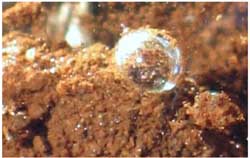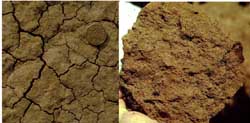Practical Note: Aggregate Stability
Download the PDF version of this document: Practical Note: Aggregate Stability (PDF 509KB).
To view the information PDF requires the use of a PDF reader. This can be installed for free from the Adobe website (external link).
Well aggregated soil is important. It has pores between aggregates and within the aggregate. Large pores allow for the exchange of oxygen and other gases with the atmosphere, while small pores hold plant available water and dissolved nutrients.
| The stability of aggregates in water depends on several interacting parameters: Soil texture - how much clay, silt or sand is present in any given soil. The more clay present in the soil, the more likely the soil is to form aggregates (clays carry an electric charge and can stick together). However, the clay is also the part of the soil that disperses if aggregate stability is poor. |
Clay mineralogy - the type of clay present in a soil. Different clays produce different types of aggregation and many (such as the clay mineral smectite) need to be managed with care due to the susceptibility to disperse when wet.
Binding agents - iron and silica help to stick the clay particles together and prevent them from dispersing.
Organic matter - plays a very important role in bonding aggregates together (particularly freshly decaying organic matter) and improving aggregate stability.
Exchangeable sodium - can cause very poor aggregate stability. Soils with a high percentage of exchangeable sodium are very likely to disperse and need to be managed carefully.
| The mechanics of aggregate breakdown When a fragment of soil is immersed in fresh water, there are four things that can happen:
|  Figure 1. An air bubble escaping from an air-dry aggregate submerged in water |
Swelling causes the volume of the aggregate to increase, and is often followed by the soil slaking.
Slaking is when the air-dried aggregate breaks into smaller aggregates when immersed in water. This indicates that the aggregates are not strong enough to withstand the pressures involved in wetting. Some soils are strong enough to withstand this pressure, and increasing the organic matter content of the soil may increase aggregate stability. Slaked soils can also disperse.
Dispersion is caused by breakdown of the clay aggregate into individual clay particles.
Poor aggregate stability can result in:
|  Figure 2. A crusted soil surface resulting from the dispersed clay forming a layer of clay particles (left), and a dense surface soil resulting from a decrease in large pore spaces in poorly aggregated soil |
What can I do to improve aggregate stability?
Aggregate stability is influenced by both soil properties, and the history of management. Improvement can therefore be achieved both by modifying soil properties, and by increasing the utilisation and incorporation of organic matter.
- Retain crop stubble – this can help to protect the soil surface from the impact of rain drops and can improve soil structure by increasing organic matter. The roots of stubble also help to create cavities in the soil for macrofauna to live in and provides a food source for soil biota. Shade is also provided by stubble, creating a better environment for soil biota.
- Limit vehicle traffic – controlled traffic and the removal or limitation of livestock from wet paddocks helps prevent soil degradation.
- Apply gypsum – if your soil is sodic then applications of gypsum can help to correct the imbalance of exchangeable sodium. Seek advice on applying gypsum before you proceed, particular relating to sodicity at depth.
- Green manure or compost – will increase organic matter content and help to bond aggregates together.
- Raised beds – in areas where waterlogging is a problem, raised beds can alleviate pressures on soil structure by draining excess water away.
- Direct drill or minimum tillage – will prevent degradation of the soil and thereby encourage better aggregate stability. Less mechanical pressure placed on the soil will allow the ‘natural’ stability of the soils aggregates to develop.
Reference
Baxter NM & Williamson J (2001) Know Yours Soils – Assessing Yours Soils (Part 2). Department of Primary Industries, Bendigo Victoria. ISBN: 0 7311 4557


